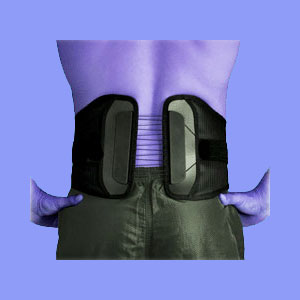
A sciatica back brace is one of the most commonly used home orthotic treatments for ongoing lower back and leg pain. However, a back brace is sometimes one of the most useless of all therapy modalities, since it will do nothing at all to prevent spinal injury and might only provide minor muscular support. A back brace is certainly not likely provide any relief for structural spinally-enacted sciatica pain, although the vast majority of patients who use these devices do enjoy a moderate placebo benefit from their use.
This essay provides a look at using various types of back braces to relieve the effects of sciatic nerve symptoms. We will explain why back brace applications are usually illogical for most suspected causes of sciatica.
Sciatica Back Brace Use
Sciatica is medically defined as a back and leg pain syndrome which is usually caused by a compressed or chemically-irritated nerve root in the lumbar spine. According to this definition, how can any healthcare provider justify recommending a brace for symptomatic relief?
Sure, a lower back brace might provide muscular support for people doing physical labor, but will definitely not prevent pain due to a pinched nerve. It will not minimize spinal movement, support the spinal column or any other nonsense which it is generally believed to provide.
A back brace is appropriate for muscular support only and will not alleviate the supposed causes of structural sciatica. Nevertheless, back braces are indeed used by patients with general lower back pain, and sciatic nerve pain, in particular. Most patients claim to feel safer with the feeling of security the brace provides. They say that the brace holds them in and prevents their backs from going out.
The construction of most of these braces is akin to a large comfortable rubber band, which is unlikely to adequately hold together a stack of newspapers on a windy day, forget about supporting the amazing range of movement possible from a human spine.
Back Brace Concerns
Patients who use a back brace might get a placebo benefit from their Velcro or leather security blanket. However, they are not likely to derive any real tangible benefit from their back braces. Additionally, if they continue wearing it nonstop, they may be doing actual damage to their back muscles.
Continued use of a support brace weakens the postural muscles, since they begin to rely on the sciatica back brace to help them do their jobs. This is even more obvious in patients who try to minimize movement in their painful spinal levels. These individuals are actually creating a physical problem, where none was likely to exist prior to wearing the ridiculous brace.
Braces certainly have appropriate applications for patients who are recuperating from injury or surgery, as well as for patients who have particular types of spinal curvatures, such as scoliosis. However, as a stand alone therapy for sciatica, most orthotics are illogical and counterproductive.
Sciatica Back Brace Cautions
Ok, I admit it. I used to wear a brace also, but only for a short time of naivete. I tried so many, from the common elastic drug store type to a $900 custom made leather and metal-boned contraption which resembled a corset. Every doctor who recommended one swore that it would provide relief and 90% of them just happened to sell the braces themselves. I wonder if the possibility of selling these overpriced bandages might have contributed to their recommendations. What do you think?
I thought these nonsensical items were really helping me and I also derived a placebo from them. After all, they were prescribed and did such a good job holding me together around that painful area, right? Well, looking back after learning much about back pain and why it occurs, I laugh when I think of these back braces.
For my diagnosed condition, which included degenerative disc disease and 2 herniated discs, these braces did nothing at all. Worse yet, the same doctors who recommended them also had my diagnosis completely incorrect, as well.
You might want to really consider the actual benefits you are getting from your trusted old brace. Is it really helping you?
or
Is it merely another factor perpetuating your symptoms, by making you focus on a mistakenly identified source of pain all along?





